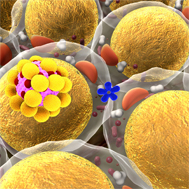Introduction: Can Fat cells grow back after liposuction?
Can Fat Cells Grow Back After Liposuction? Liposuction describes a surgery that literally sucks fat cells out of your body. This means that the fat cells that have been removed with liposuction can never come back. Despite this basic premise, patients still ask me routinely whether fat cells can grow back. This question arises because patients who undergo liposuction and then gain weight after their surgery will notice growth in the girth of areas that still contain a high density of fat cells. This observation results because following liposuction patients cannot gain any significant weight in areas that have undergone liposuction because these areas are depleted of any fat cells.

Instead, as the patient gains weight, excess fat molecules must be stored in any areas that still have an abundant amount of fat cells remaining. These areas are typically problem areas that were not addressed during their liposuction. In contrast, areas liposuctioned on their body that have very little fat cells left will not gain in girth. This leads to the typical patient comment “the fat cells grew back!” With even small weight gain, existing fat cells simply get bigger by accumulating more fat molecules within the existing cell. When there is an excess caloric intake, the body creates molecules that need to be stored in fat cells. This is an important concept that many people don’t appreciate.
When you gain weight, you don’t get more fat cells; instead, the fat cells you already have become larger. This is in contrast to weight gain in children, who will actually get an increase in the number of fat cells. Increasing numbers of fat cells are formed from existing stem cells by a process of differentiation with the creation of preadipocytes that then mature into full adult fat cells. This is why childhood obesity is such a detrimental process that will lead to adulthood which is much more vulnerable to weight gain. The daunting fact is that they have a much higher number of fat cells than those who did not experience childhood thus making them more prone to fat molecule storage and an increase in fat cell volume.
Can fat cells grow back after liposuction? The answer is a definite “No”. However, other fat cells that you have can grow larger. This is why Lipo 360 ensures that all problem areas, i.e. areas that have a high density of fat cells, are eliminated. Following Lipo 360, patients are protected from developing disfigurement with even modest weight gain. If you are interested in undergoing Lipo 360, we recommend you consider a complimentary consultation to evaluate your body fat deposition. This protection is gained by making sure that all of your body areas have the same fat density. As a result, even modest weight gains will result in a uniform distribution of fat molecules evenly throughout all of your fat cells.
Understanding: Can Fat Cells Grow Back After Liposuction?
Liposuction is one of the most popular cosmetic surgeries performed today. Over 313,000 liposuction procedures were done in the United States in 2020 alone. [1] This body contouring treatment aims to remove stubborn fatty deposits that are unresponsive to diet and exercise. But many wonder—once fat cells are removed, can they grow back?
While the fat cells suctioned out during liposuction are permanently gone, the remaining fat cells can still expand. So under certain circumstances, it may appear as if the fat has returned after liposuction. Let’s take a closer look at how fat cell regeneration works after this procedure.
How Liposuction Removes Fat
Liposuction slims specific areas of the body by literally sucking out the fat. A thin tube called a cannula is inserted through tiny incisions in the skin. The dislodged fat cells are then suctioned out as the surgeon moves the cannula back and forth in the treatment area. [2]
Some of the most common sites for liposuction include the:
- Abdomen
- Flanks and back
- Hips and thighs
- Neck and chin
- Arms
Local anesthesia or general anesthesia is used so the procedure can be performed on an outpatient basis. Results are permanent as long as weight is maintained through proper nutrition and fitness.
Do Liposuctioned Fat Cells Regenerate?
The fat cells removed during liposuction are permanently eliminated from the body. They do not regenerate or grow back in those treated areas. When performed correctly by an experienced surgeon, liposuction results in lifelong fat reduction in those specific sites. However, patients may still experience some enlargement in the treated areas over time. This is not due to the regrowth of liposuctioned fat cells, but rather the expansion of remaining fat cells. Here’s why:
Fat Cell Expansion After Weight Gain
Each fat cell can increase in size when excess calories are consumed. Someone who was 135 pounds before surgery might have 400 billion fat cells. [3] Let’s say liposuction removes 10% of that or 40 billion cells. Those cells are gone for good. But if that person later gains a significant amount of weight, the remaining 360 billion cells expand. Those enlarged fat cells can make it appear as though the liposuctioned fat has returned. In reality, the treated areas are still 10% smaller in terms of fat cell count. But the fat cells that remain stretched out with added body fat. This is why weight management is crucial for maintaining a sculpted post-liposuction appearance.
Hyperplasia in Untreated Areas
In addition to fat cell expansion, the body can also respond to substantial weight gain by creating new fat cells. This process is called hyperplasia.
So while the liposuctioned areas have fewer fat cells that cannot come back, untreated areas may develop new fat cell formation. This can cause disproportionate fat distribution or bulges in areas that were not addressed by liposuction.
Again, the key is maintaining a stable body weight and percentage of body fat. This helps minimize both hypertrophy (fat cell expansion) and hyperplasia (formation of new fat cells).

Factors That Influence Fat Regrowth
Whether or not a patient experiences noticeable enlargement in treated areas after liposuction depends on several factors:
Amount of Fat Removed
Removing larger amounts of fat cells in one or more regions leaves fewer cells behind that could potentially expand. Conversely, more conservative fat removal may still allow enough cells to hypertrophy and affect appearance.
Number of Years Since Surgery
Gradual fat cell expansion over decades can have a cumulative effect. Areas may appear more enlarged 20 years after surgery compared to just 2 or 3 years later.
Significant Weight Gain
Liposuction cannot prevent fat re-accumulation with considerable weight gain. Each pound gained increases the size of fat cells bodywide. This is especially noticeable in areas with fewer cells.
Weight Fluctuations
Frequent shifts in weight make fat hypertrophy more likely. The liposuctioned areas can become noticeably larger during periods of weight gain.
Liposuction Technique
The skill of the surgeon and the precision of the technique also influence results. Incomplete fat removal or irregular contours make fat re-accumulation in treated areas more visible.
Can Diet and Exercise Reduce Fat After Liposuction?
Proper nutrition and regular exercise are essential for keeping fat off after liposuction. While the procedure permanently removes some fat cells, it should be thought of as a jumpstart rather than an alternative to diet and exercise.
With a healthy lifestyle, patients can help minimize the expansion of fat cells in the treated and untreated areas. Combining liposuction with improved eating habits and fitness:
- Helps keep fat from returning to treated areas
- Prevents disproportionate bulges in untreated zones
- Maintains a slimmer overall figure
In many cases, the motivation and accountability from surgery help patients implement beneficial lifestyle changes. Sticking to these new habits is the best way to make liposuction results last.
Takeaways on Fat Cell Regrowth
In summary, the key points to understand about “Can fat cells grow back after liposuction?” include:
- The liposuctioned fat cells are gone permanently
- Remaining fat cells can still expand with weight gain
- New fat cell formation may occur in untreated areas
- Diet and exercise after surgery are critical
- Some enlargement in treated areas is possible years later
- Selecting an expert surgeon provides optimal results
While a perfect body contour for life is unrealistic, liposuction produces lifelong improvements in treated areas when weight is kept stable.

Conclusion: Can Fat Cells Grow Back after Liposuction?
The final answer is no. Fat cells cannot grow back after they have been removed. However, the remaining fat cells can get bigger if you gain weight. Here are some tips to help keep your contours looking smooth and proportional after liposuction:
- Follow a healthy, low-calorie diet focusing on lean proteins, fruits/veggies and whole grains
- Incorporate regular cardio and strength training into your fitness routine
- Wear compression garments as directed post-surgery
- Keep follow-up visits with your plastic surgeon
- Maintain a stable body weight near your liposuction weight
- Notify your surgeon of changes in shape or disproportionate bulges
With realistic expectations and proper lifestyle habits, patients can enjoy long-lasting improvements from their liposuction investment. We hope that we have answered your question, “Can fat cells grow back after liposuction?”
References:
[1] American Society of Plastic Surgeons. Plastic Surgery Statistics Report. 2020. Accessed November 19, 2023. https://www.plasticsurgery.org/documents/News/Statistics/2020/plastic-surgery-statistics-full-report-2020.pdf
[2] American Society of Plastic Surgeons. Liposuction. Accessed November 19, 2023. https://www.plasticsurgery.org/cosmetic-procedures/liposuction
[3] Harvard Health Publishing. Why dieting doesn’t usually work. Accessed November 19, 2023. https://www.health.harvard.edu/staying-healthy/big-thighs-may-be-wise

